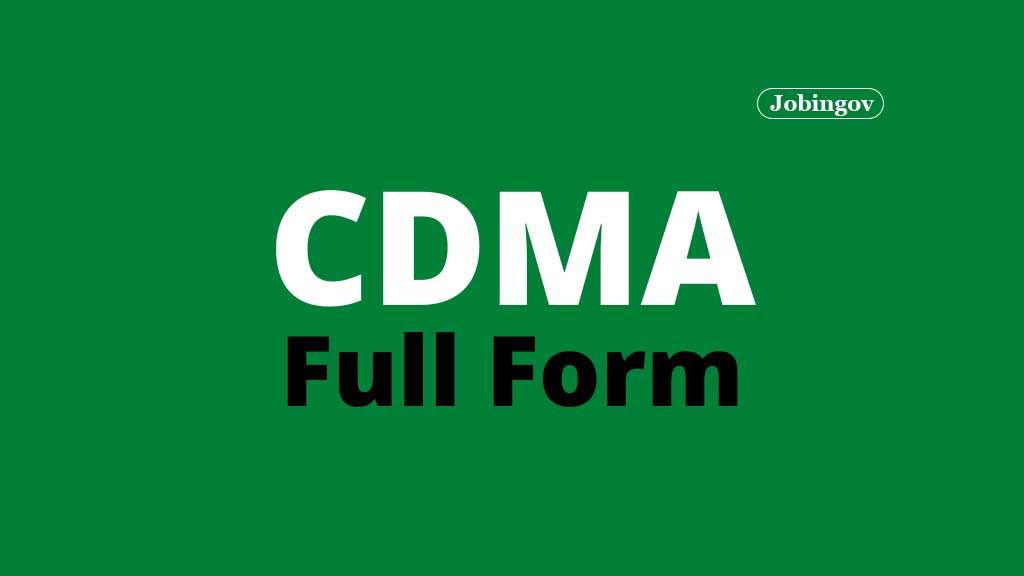What is the full form of CDMA?
The abbreviation CDMA stands for Code Division Multiple Access. This is based on the channel technology that is modified by the commercial cellular system for better communication of the users. Various mobile company use this method for standard connection. Generally, this is used in mobile for communication.
Multiple Access indicates that information can be send through several transmitted simultaneously in a single communication channel. Here, users get different CDMA codes and able to use that bandwidth throughout the whole duration.

Available bandwidth is optimized by it as the entire frequency range is transmit and doesn’t affect the user’s frequency range. A band of frequencies can be shared by multiple users without interfering between them.
Through CDMA, it is possible to use spectrum technology and analog to digital conversion (ADC).
History of CDMA
The use of CDMA technology has been recorded many years back. Dmitry Ageev, for the first time published this subject in 1935. During world war-II, technology of CDMA was used to overcome the problem of jamming transmissions.
So, military used this technology in anti-jamming, ranging, etc. Leonid Kupriyanovich used this technology during the preparation of automatic wearable mobile phone.
CDMA technology was approved by the Telecommunications Industry Association (TIA) in 1993. It was recorded in September 1998 that there were approximately 16 million subscribers of CDMA system. In present day, 22 countries supported this this CDMA system.
Features of CDMA
- Many users are able to connect at a certain time that improves the capacity of voice and data communication.
- CDMA used complete spectrum by all the channels.
- Power control is used by the CDMA system to avoid external interference & noise that makes it an improved and quality network.
- User transmissions are being encoded by the CDMA system into special and separate codes that protects its signals.
- Through the CDMA system all the cells are able to use the same frequency.
- In a CDMA system unlimited number of users can participate but it is to be noted that when the number of users will increase the performance will also degrade.
Application of CDMA
- It has an application in the GPS (Global Positioning System).
- The technology of CDMA is widely used by the various cell phone companies (such as Qualcomm standard IS-2000 also known as CDMA2000).
- W-CDMA has an application in UTMS 3G mobile phone standard.
- CDMA was an application in the OmniTRACS satellite system for the purpose of transportation.
Types of CDMA
Generally, there are two types of CDMA system such as:
- Synchronous CDMA (orthogonal codes)
- Asynchronous CDMA (pseudorandom codes)
Advantages of CDMA
- One of the most important advantage of CDMA system is that it can be used by a lot of users compare to TDMA or FDMA.
- CDMA is considered as more secure because it is difficult to make intrusion of this spectrum that transmit information below the noise floor.
- In comparison of GSM, CDMA face less dropouts making its use in the rural area comfortable.
- Users need less investment in CDMA calls than GSM.
- Users can enjoy high quality voice having no disturbance during calls.
- Users will not face problems like multipath and fading in the CDMA system.
- Power consumption in CDMA is very low.
- Transformation of data is faster in CDMA than GSM.
- Radiation exposure is less in CDMA cells than GSM.
Disadvantages of CDMA
- In CDMA system, customers use orthogonal codes, so, to maintain orthogonality between codes is very important to recover data.
- Users who are very away from the base station is difficult to recover data.
- The procedure is very complex that are related to soft handoff.
- It is found that, with the increase of number of users the performance of this system degraded.
- In CDMA system, users who are closer transmit less power than the furthest users.
- International roaming is not available in CDMA system.
More Related Full Forms:
CDMA Full Form: FAQs
Q1. What is the full form of CDMA?
Ans: The full form of CDMA is Code Division Multiple Access which is also known as spread-spectrum technique.
Q2. Which type of technique is used in CDMA?
Ans: In CDMA system, various signal is transmitted into a signal channel. Available bandwidths are optimized. Generally, the technique of CDMA is used in the ultra-high-frequency (UHF) cellular telephone systems that has range between the 800-MHz and 1.9-GHz.
Q3. What is the use of CDMA?
Ans: Cellular communication in the commercial area, the technology of CDMA is used that makes radio spectrum better than other technologies.
Q4. Can a user able to use both CDMA and GSM in a phone?
Ans: In the new generation mobile phones, users can use both CDMA and GSM technologies in a single phone. So, you don’t need to be worry about your phone whether it is CDMA enable or GSM enable.
Q5. Does any SIM require in CDMA technology?
Ans: CDMA technology doesn’t require any SIM and are not compatible with the GSM network, makes it very difficult and expensive to change both phone and network.
Q6. What are the types of CDMA?
Ans: There are two types of CDMA as (i) Synchronous CDMA (orthogonal codes) (ii) Asynchronous CDMA (pseudorandom codes).
Q7. Can we unlock the CDMA phones?
Ans: Yes, by entering the special “unlock” code, we can unlock the CDMA phones.
Q8. Which country install CDMA system for the first time?
Ans: Hong Kong in 1995 install CDMA system for the first time and also commercialized it.
Q9. When was the CDMA technology approved by Telecommunications Industry Association (TIA)?
Ans: The CDMA technology was approved by Telecommunications Industry Association (TIA) in 1993.
Q10. Why CDMA technology was used during the world war II?
Ans: CDMA technology was used during the world war II to overcome the problem of jamming transmissions.
Conclusion
We hope this post will help you to know the CDMA Full Form, History, Features, Application, Types of CDMA, Advantage, Disadvantage, etc. For get more full form like this visit this website regular basis. Also, you can follow us on Facebook and Twitter to get latest post notification immediately.





